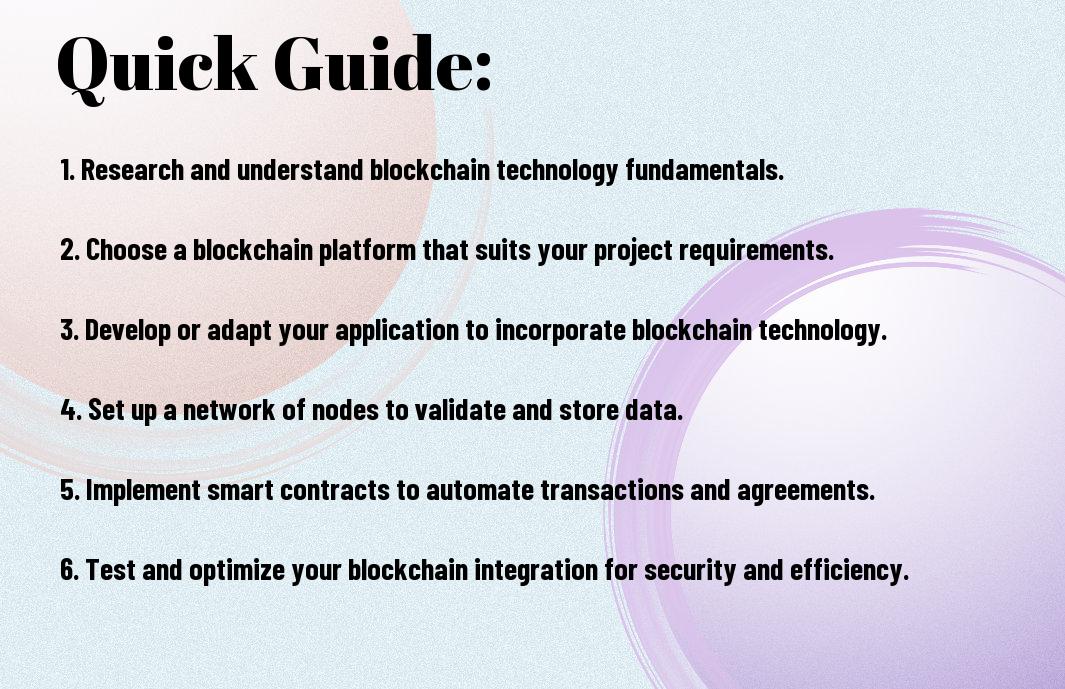You’ve heard about blockchain technology and its potential to revolutionize various industries, but now you’re wondering how to actually implement it in your business. In this guide, we’ll walk you through the process of integrating blockchain technology into your operations, step by step. Whether you’re a small start-up or a large corporation, understanding the ins and outs of blockchain integration is crucial for staying ahead in the digital age. For a more in-depth look at implementing blockchain technology in business, check out our guide How to Implement Blockchain in Business? A Complete Guide.

Understanding the Types of Blockchain
You may have heard about blockchain technology being hailed as a revolutionary innovation, but do you know that not all blockchains are created equal? Understanding the different types of blockchains can help you navigate the complex world of decentralized ledgers more effectively.
| Public Blockchains | Private Blockchains |
| Consortium Blockchains | Hybrid Blockchains |
Public Blockchains
An open and decentralized network, public blockchains are accessible to anyone who wants to participate. Transactions are transparent and can be viewed by anyone in the network, providing a high level of security through decentralization and consensus mechanisms.
Private Blockchains
Blockchains are closed networks where only authorized participants have control over the network. This type of blockchain offers more privacy and faster transactions, making it ideal for businesses looking to harness blockchain technology for internal operations.
With private blockchains, companies can customize the blockchain according to their specific needs and have the flexibility to set permissions and access controls as per their requirements.
Consortium Blockchains
Blockchain is a semi-decentralized network where a group of organizations controls the consensus process. It offers a balance between the openness of public blockchains and the restrictions of private blockchains, making it suitable for industries that require both transparency and control.
Plus, consortium blockchains are more scalable than public blockchains and require less energy consumption compared to proof-of-work algorithms.
Hybrid Blockchains
Nowadays, hybrid blockchains are gaining popularity as they combine the best features of both public and private blockchains. For instance, they can offer transparency where needed while protecting sensitive data using private channels.
Step-by-Step Guide to Integrating Blockchain
Assessing Your Blockchain Needs
With the first step to integrating blockchain, you need to assess your business needs and goals. Determine which processes can benefit from blockchain technology and what you aim to achieve by implementing it. Identify the pain points you want to address and the data you want to secure.
Selecting the Right Blockchain Platform
Even though there are various blockchain platforms available, choosing the right one for your specific requirements is crucial. Evaluate factors like scalability, security features, consensus mechanisms, and smart contract capabilities. Consider whether a permissioned or permissionless blockchain suits your business needs best.
This selection is a critical decision that will impact the success and efficiency of your blockchain solution. Ensure you thoroughly research and compare different platforms before making a choice.
Planning and Designing Your Blockchain Solution
For planning and designing your blockchain solution, map out the workflow of your processes and transactions. Determine the architecture that best fits your requirements, whether it’s public, private, or hybrid. Develop a comprehensive plan outlining the development stages, timeline, and team responsibilities.
Blockchain technology offers a wide range of solutions, so it’s vital to tailor your design to your specific business objectives and operational needs. Create a detailed roadmap to guide your development process effectively.
Development and Testing
Guide your development and testing phase by selecting experienced developers who specialize in blockchain technology. Collaborate closely with your team to ensure seamless integration of the blockchain solution into your existing systems. Utilize robust testing methods to identify and rectify any issues before deployment.
Another crucial aspect of this phase is to ensure your smart contracts are thoroughly audited and tested to guarantee their reliability and security once deployed.
Deployment and Monitoring
Platform your blockchain solution deployment carefully by choosing the right time and ensuring sufficient resources for a successful launch. Implement monitoring tools to track performance, detect anomalies, and address any issues promptly. Regularly update and maintain your blockchain solution to optimize its efficiency and security.
Right from deployment, monitoring is vital for the smooth functioning of your blockchain solution. Proactive monitoring ensures timely intervention and enhances the overall performance and reliability of your system.

Tips for a Smooth Blockchain Integration
Unlike traditional IT projects, integrating blockchain technology requires a unique set of considerations. To ensure success, here are some tips to keep in mind:
- Building a Skilled Team
- Ensuring Compliance and Security
- Managing Data and Privacy
Building a Skilled Team
Little expertise in blockchain technology can create significant roadblocks during integration. Assemble a team with a mix of experienced blockchain developers, IT professionals, and business stakeholders. Investing in training and upskilling current staff can also help bridge the knowledge gap.
Ensuring Compliance and Security
Compliance with regulations and security measures is crucial when integrating blockchain technology. Conduct thorough audits, implement robust security protocols, and ensure that all team members are aware of best practices. Regularly update systems and stay informed about the latest developments in blockchain security.
Managing Data and Privacy
Skilled management of data and privacy is vital when implementing blockchain technology. Data must be securely stored, and access should be restricted to authorized personnel only. Implement encryption and access controls to safeguard sensitive information.
Evaluating the Integration
Factors to Consider Post-Integration
Your blockchain integration is complete, but the journey doesn’t end there. Now it’s time to evaluate the success of the integration. Consider key factors such as security, scalability, efficiency, and user adoption to ensure that your blockchain technology is adding value to your business. Knowing where improvements are needed can help you optimize your blockchain solution for better performance and outcomes.
Analyzing the Pros and Cons of Blockchain for Your Business
| Pros | Cons |
| Increased security | High initial implementation cost |
| Transparency and immutability | Scalability challenges |
| Decentralization | Regulatory uncertainty |
| Efficiency and cost savings | Complexity of integration |
Post-integration, it’s important to weigh the pros and cons of blockchain technology for your business. While benefits like increased security, transparency, and decentralization can enhance your operations, challenges such as high implementation costs, scalability issues, and regulatory uncertainties need to be carefully considered.
Final Words
Taking this into account, integrating blockchain technology into your business can significantly enhance transparency, security, and efficiency. By following the steps outlined in this guide, you can successfully incorporate blockchain into your operations and stay ahead of the curve in the fast-evolving digital landscape. Embrace the potential of blockchain technology and unlock new opportunities for growth and innovation within your organization. Remember to stay informed on the latest advancements in the blockchain space to continue leveraging this transformative technology to its fullest extent.
FAQ
Q: What is blockchain technology?
A: Blockchain technology is a decentralized, distributed ledger that securely records transactions across a network of computers. It enables secure and transparent transactions without the need for intermediaries.
Q: How can I integrate blockchain technology into my business?
A: To integrate blockchain technology into your business, you can start by identifying areas where transparency, security, and decentralization are crucial. Consider using blockchain for supply chain management, digital identity verification, smart contracts, or payment processing.
Q: What are the benefits of integrating blockchain technology?
A: Integrating blockchain technology can provide benefits such as increased security, reduced costs through automation, improved transparency, faster transaction speeds, and enhanced trust among stakeholders. It can revolutionize industries by streamlining processes and ensuring data integrity.
